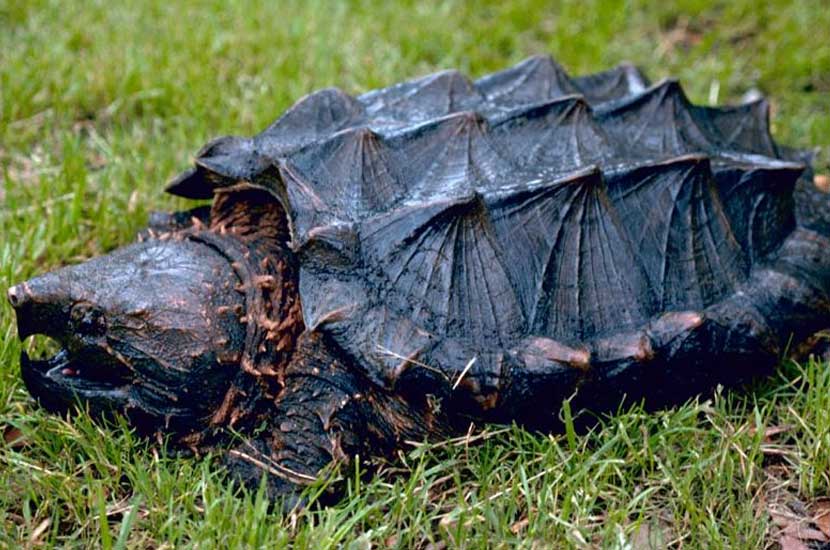Natural History
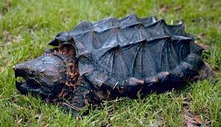
Alligator snapping turtles inhabit deep waterways such as large rivers, canals, lakes, bayous, and swamps. Alligator snapping turtles are found only in a select number of states in the southern portion of the United States. Illinois, Indiana, Ohio, West Virginia, Texas, Mississippi, Florida, Louisiana, Arkansas, Georgia, Oklahoma, and Missouri are all inhabited by this species. This species of turtle is extremely hardy but is listed as Vulnerable by IUCN. Although they are renowned for their impressive jaw strength and aggressive nature, the snapping turtle is very timid underwater but will become defensive on land. However, young alligator snapping turtles are notorious for their fiery personalities. It is recommended to avoid a snapping turtle out of its aquatic habitat due to their ability to turn and lunge with their impressively long necks to deliver a very painful bite.
This chelonian’s claim to fame is their hunting technique. Alligator snapping turtles will lay on the bottom of their aquatic environment camouflaged with the muddy bottom with their mouths wide open. Inside their mouth is a small pink vermiform (worm shaped) tongue that acts as a fish lure using Peckhamian mimicry. Once the unsuspecting prey enters the jaws to nibble on “the worm”, the jaws are closed and the prey item swallowed. This is not the only way these animals hunt, some individuals, especially juveniles, will hunt for their meals and ambush.
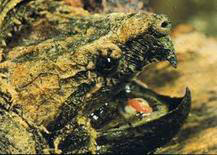
This species is renowned for their quick growth and long life span with proper care. Alligator snapping turtles have become their own urban legend with claims of some specimens living well past 150 years. On average, males are smaller than females with most males weighing 25-75 lbs and females weighing 70 to nearly 200 lbs! The largest recorded representative of this species had a 31.5 inch long shell and weighed in at 316 pounds. Generally, this species will have a shell length of between 15 and 26 inches. Alligator snapping turtles are the world’s heaviest freshwater turtle! Most of these animals in captivity are from the wild and females in particular become “antsy” during breeding season as they set out to find a suitable nest site.
In 1975, the United States government banned the sale of any chelonian with a carapace (top shell) less than four inches long in hopes of preventing the spread of Salmonella and the destruction of native species in the wild. With the age of easily accessible information via the World Wide Web, private breeders have been successfully breeding and incubating turtle eggs and now offer their domestically bred chelonians online. As to the legalities regarding this practice, that is for the government to decide. Domestically bred turtles are always recommended over their wild caught counterparts.
Quarantine
It is recommended that all new turtles be quarantined away from the rest of the household chelonians for at least 60-90 days. In this time period the owner can access the animal’s behavior and health status. Chicago Exotics strongly urges owners to bring these animals in during quarantine for a wellness exam and a fecal evaluation. Quarantine requires food, dishes, accessories, and cleaning of the chelonian to be done separately from the other chelonians.
Temperature
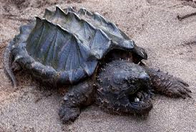
The water temperature of the enclosure can be raised using under water heaters and under tank heaters on a thermostat to keep the water at 75-80° F. Hatchlings should be kept around 78-80° F, however. Animals from northern portions of the range require the cooler end while animals from the southern portion require the upper end of the temperatures. A thermometer in the water is highly recommended at the location furthest away from any heat source and one near the heat source. If a submersible heater is used, it is recommended to place a piece of PVC pipe with several holes drilled into the sides of it over the heater to prevent accidental burns. A general rule of thumb is a 55 watt water heater will work for a 40 gallon tanks, a 75 watt heater for a 55 gallon tank.
The air temperature in the tank can be easily raised using a basking light or a ceramic heat emitter. Metal dome clamp lights work well for this. Under tank heaters can also be utilized. A thermometer should be place on the opposite side as the basking light and another thermometer placed at the level the chelonian will be while basking. The ambient (air) temperature should be 80-86° F with the basking site reaching near 90° F.
Enclosure
Snappers are difficult to house due to their fast growth rate and impressive size. This species loves to swim and explore their enclosures. Hatchlings can be comfortably kept in a 20-50 gallon tank or equivalent container for almost a year. An 8 inch long juvenile will require a 55-gallon or larger enclosure or similar size plastic tote. Adults generally require a 200-800 gallon enclosure. Stock tanks, modified plastic tubs, outdoor ponds, and koi tubs work well. Remember, bigger is better! With a bit of creativity, enclosure potential is endless! The water should be deep but the turtle must be able to stand normally without touching the water surface as this species prefers to walk along the bottom of their enclosures. This species also requires the water to be visibly flowing as it would be in their natural habitat. Ideally, the water should be deep enough for the snapper to stand and extend its neck to break the water surface with a portion of its head.
This species rarely basks outside of the water but they will float to the surface of the water to warm themselves. Snappers do require a land area where they can haul themselves out of the water completely if desired. Females are prone to wandering in order to find a suitable site for a nest and may require a larger enclosure or at the very least, a dig box.
Substrate
With snapping turtles, it is recommended to have a bare bottom tank, one without substrate. If substrate is desired for enrichment or aesthetic purposes, large gravel that the turtle cannot fit into its mouth can be used. Weekly agitation (stirring up the stones to give the filters a chance to filter out the debris) and siphoning of the debris. A word of caution, if substrate is used; an under gravel filter is not enough filtration to maintain a clean environment and will need to be supplemented with other filtration devices. Every 2-4 weeks the rocks should be removed from the tank and scrubbed well with a toothbrush designated for the job and bleach diluted 1:20 with water.
Water
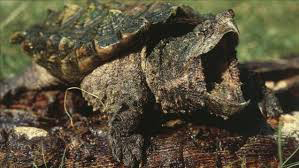
The water for these turtles is important! These are fresh and brackish water turtles that enjoy swimming. Only use chlorine free water with an addition of aquarium salt to create a brackish environment with a specific gravity of 1.015-1.018. A hygrometer and frequent salinity testing is required to maintain the water levels. Care must be taken to only use aquarium salt and not consumable sea salt or iodized table salt. Snapping turtles enjoy a mild current in the water which can be created using strong filters or water jets. Change a third of the water once a week to keep water clean.
Canister filters are recommended by Chicago Exotics for all aquatic chelonians. These filters offer both mechanical and biofiltration and are less stressful to aquatic turtles as there is no mechanical vibration on the tank from the filter body itself. Fluval, Magnum, and Eheim make excellent filters and there are a few websites that illustrate how to create your own canister filter. For full grown adult enclosures, it is recommended to invest in a pond filter with a secure inlet. External filtration helps to remove uneaten food and large waste particles as well as agitate surfaces and increase water oxygenation. Alligator snapping turtles require flowing water in their enclosures to simulate natural environments. Full water changes must be done weekly to maintain health and sanitation of the enclosure as well.
Lighting
As with most reptiles, snapping turtles do well on a light cycle that simulates 12 hours of daylight and 12 hours of darkness. A high quality UVB bulb such as a 5.0 ReptiSun bulb is recommended for adults and a 10.0 ReptiSun bulb is recommended for hatchlings and young turtles. These bulbs help the body convert D into D3 which helps the body absorb and metabolize calcium thus preventing the disfiguring and deadly metabolic bone disease which is generally caused by a lack of available calcium in the reptiles’ body.
Accessories
Enclosure accessories are necessary for enrichment and promotion of healthy behavior patterns. A hide area provided underwater in the form of a broken flower pot, sturdy and anchored rock structures, or commercially available underwater hides are necessary to give the turtle a place to hide from sight. This promotes a feeling of security. However, as the snapping turtle grows, the hide box design will become increasingly more creative. Artificial and real plants are fantastic and offer visual appeal as well as more hiding places. Live plants may be eaten or uprooted but are enjoyed by snappers. Duckweed, water lettuce, and water hyacinth are easy to keep and find.
Alligator snapping turtles require lots of visual underwater barriers to help them feel more concealed. Driftwood, rocks, stumps, and other creative obstacles are relished.
Feeding
Snappers less than 6 months old should be fed twice daily and turtles over 6 months old should be fed once every other day. These animals must be fed in the water to facilitate swallowing as their tongues are not meant to push food to the back of the mouth for swallowing. It is recommended to offer as much food as will be consumed in a period of 10-15 minutes to avoid obesity and water fouling from rotting food. If the water is becoming fouled too quickly and obesity is starting to be a problem the amount of food offered should be decreased. All food should be sprinkled with a multivitamin once a week and a calcium supplement daily for hatchlings and three times a week for adults.
These turtles are omnivores as adults and primarily carnivores and piscivores (fish eaters) as juveniles. Alligator snapping turtles will consume fresh water, crayfish, earthworms, pelleted diets, floating duckweed, water lettuce, and water hyacinth in their enclosure. Likewise, they will nibble on floating leaves of lettuce which also offers them some enrichment. The key to a healthy turtle is to offer variety in the diet. Fish (not goldfish) can be offered to snapping turtles but it is preferred they either be slow moving or frozen-thawed as this species is not adept at catching fast moving prey and are more likely to scavenge a dead fish body or ambush their prey in the wild. Insects such as earthworms, crickets, and snails should be offered as well as food items such as crayfish to younger and smaller snappers.
Supplementation with commercially produced turtle, trout, or catfish pellets. Some owners prefer to feed only commercially produced turtle pellet diets, in this case, Chicago Exotics recommends feeding multiple brands of turtle pellets to insure adequate nutrition and offer enrichment through variety and shape difference.
Sources and Recommended Readings
Turtles of the World – Carl H. Ernst and Roger W. Barbour
Turtles of the United States and Canada – Carl H. Ernst, Jeffery E. Lovich, Roger W. Barbour
Keeping and Breeding Freshwater Turtles – Russ Gurley
Aquatic Turtles – David T. Kirkpatrick
Turtles and Tortoises – R. D. Bartlett
www.tortoisetrust.org – Tortoise Trust

